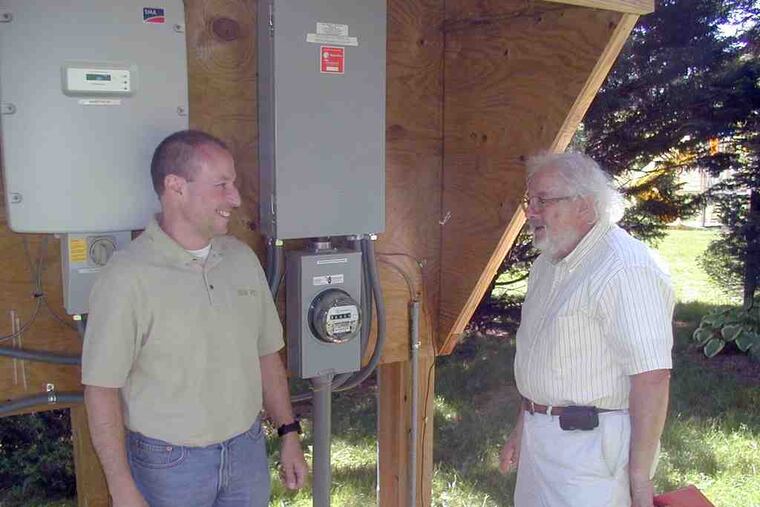Solar energy output is outpacing Pa. mandate
While the sun beat down last week on a $187,000 rooftop solar system on his Chester County barn, Edward Frankel watched his electrical output add up.

While the sun beat down last week on a $187,000 rooftop solar system on his Chester County barn, Edward Frankel watched his electrical output add up.
Every two minutes, a meter ticked off another kilowatt-hour of power generated by the 150 solar panels Frankel installed last year at his Honey Brook farm.
For every 1,000 kilowatt-hours the system produces, Frankel earns one Solar Renewable Energy Credit - an SREC, the coin of the realm in green energy.
"Almost 37 SRECs," Frankel, a veterinarian, said as he watched the cumulative total on the electric meter climb toward 37,000 kilowatt-hours. "Yes!"
Last year, Frankel was more enthusiastic about SRECs, when utilities paid him more than $300 for each credit. Now a cloud is gathering over his cash flow. The SREC price has crashed to under $100.
"I think you'd be nuts to build a system in Pennsylvania today," said Frankel, 73. He canceled plans to install a second solar system on his veterinary practice, the Honey Brook Animal Hospital.
Pennsylvania's booming solar industry is going bust.
Attracted by 30 percent federal tax credits and state grants aimed at stimulating pollution-free electricity production, Frankel and thousands of other property owners went solar in the last two years. Taxpayers covered $106,000 of Frankel's 30-kilowatt system, or 57 percent of the cost.
Enthusiasts like Frankel were also counting on receiving solar energy credits for the power they produce to make their projects work. The costs of the credits are paid by electricity consumers rather than taxpayers.
But about 71 megawatts of solar capacity is now in place in Pennsylvania, while a 2004 law requiring utilities to buy a steadily increasing portion of renewable power envisions a demand of only 42 megawatts. The result: SREC prices are falling faster than anticipated.
The solar industry says the market may remain oversupplied for several years unless the legislature steps in. It is lobbying Harrisburg to accelerate the annual increases for solar-power mandates for the next three years.
Legislation introduced by State Rep. Chris Ross (R., Chester) would also ban out-of-state projects from selling their credits to Pennsylvania utilities.
Solar advocates say the changes would not cost consumers very much since solar energy still would make up less than one-tenth of 1 percent of the total power utilities must buy. The bill would also not change the state's target for 2021 that 0.5 percent of electricity must come from the sun.
But conventional power producers and big industrial electrical customers, which have defeated efforts the last two years to increase renewable mandates, are likely to resist the latest effort to boost solar markets.
Gov. Corbett has not taken a public position, but the solar industry will frame the legislation as an effort to save Pennsylvania jobs, rather than an effort to prevent climate change.
"The governor seems to be on the fence, neither an adversary nor an advocate," said Andrew Kleeman, senior vice president of Mercury Solar Systems Inc., a New York state contractor whose Philadelphia office Kleeman heads.
The state's nascent solar industry says it is already contracting. Multistate companies such as Mercury are directing their Pennsylvania employees to focus on other states such as Maryland and Massachusetts, where demand is stronger.
"It's going to hurt the industry a lot, and the little guys a lot more," said Vadim Polikov, chief executive officer of Astrum Solar Inc., a Maryland company whose Pennsylvania sales have soured.
"There's going to be hundreds and hundreds of people whose SREC checks this year will go down, and they're going to call up their installer, who may very well be out of business," Polikov said.
Guy Jacquet, the owner of Solar Pro in Delaware County who installed Frankel's system in Honey Brook, said the market for new commercial projects is dead.
"What do we need to do?" said Jacquet, a building contractor that shifted into solar when home-building shriveled up. "Move to Jersey?"
Even New Jersey's solar market, which has more robust legislative mandates and can only be supplied by in-state projects, is also showing signs of oversupply, according to brokers who aggregate and trade solar credits for a commission.
New Jersey SRECs last year sold for $600 each, or 60 cents per kilowatt-hour. Prices have fallen to $500 this year and are heading below $400 next year, according to Michael Flett, head of the Flett Exchange, a Jersey City online broker.
"When the tide goes out, you see who's really wearing clothes," said Flett, who is cautioning developers not to overrely on SREC income when planning their projects.
The crash of the SREC market will not scuttle one high-profile solar project in Philadelphia, though it will extend the number of years it takes to pay it off.
SolarBlue L.L.C., a Florida developer that last year signed an agreement to install a 500-kilowatt solar system at Lincoln Financial Field for the Philadelphia Eagles, says that a $200 decline in the SREC price would reduce solar income by $130,000 a year.
But the $30 million Eagles project includes other energy sources - the company will festoon the stadium with spiral wind turbines, and the bulk of the electrical power will be generated from a natural gas cogeneration turbine.
"Certainly the fall in SREC prices would make a difference if it were strictly a solar project," said Gin Kirkland Kinney, SolarBlue's vice president for business development.
Frankel had anticipated his solar project in Chester County would generate $12,000 in income a year, allowing him to pay off the project in five years.
Now he expects $3,000 in income, and more years to pay down his loan.
"Do we really want to have solar in this state," he said, "or don't we?"